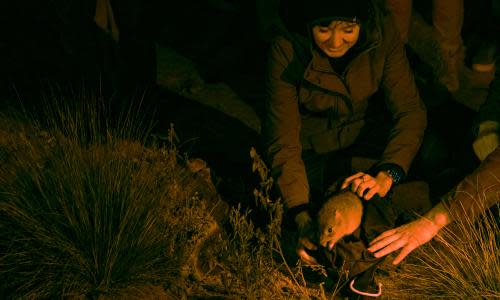Hopes rewilding critically endangered brush-tailed bettongs will help them bounce back

As in-flight meals go, sweet potato and mushroom might not be everyone’s first choice.
But it was the perfect snack for the 73 critically endangered brush-tailed bettongs as they were flown 2,000kms to a new home on South Australia’s Yorke Peninsula.
The 49 males and 24 female bettongs were caught by a team of more than 20 conservationists over five nights last week in a national park and sanctuary at Dryandra, about 180km southeast of Perth.
Related: Is that you, Migaloo? Tourist captures video of familiar-looking whale over Great Barrier Reef
The bettongs’ new South Australian home at the Dhilba Guuranda-Innes national park is the site of an ambitious rewilding project – Marna Banggara – that has now re-introduced 193 of the marsupials that were once common across Australia’s mainland.
Derek Sandow, an ecologist at South Australia’s Northern and Yorke Landscape Board, said radio transmitters fitted to most of the new arrivals show “they’re all accounted for at them moment” after the translocations started a week ago across seven flights.
Monitoring of the new population earlier this year showed the tiny marsupials were thriving in their new home.
There are as many as 15,000 bettongs living in the Dryandra Woodland national park and another 1,000 or so in a nearby sanctuary.
The south-west of WA is the species’ last remaining stronghold on Australia’s mainland after the once-common marsupial – described by Sandow as like a “mini kangaroo on steroids” – was decimated by cats, foxes and habitat destruction after European invasion.
Sign up for Guardian Australia’s free morning and afternoon email newsletters for your daily news roundup
Last week, the team set traps with baits of peanut butter balls in the woodland at dusk for the animals, known as woylies in WA and yalgi in the Narungga language of their new home.
Narungga nation representatives travelled to WA to meet the Noongar Gnaala Karla Boodja People in WA.
Within 24 hours, each animal had been driven to Perth airport, flown 2,000km to Adelaide with a sweet potato and mushroom snack, checked twice by a vet and then driven to York Peninsula and released to their new home.
Adding these new animals to the Yorke Peninsula community will help strengthen the genetic mix of the new population that have been drawn from another WA site in the Upper Warren region and a population from the feral animal-free Wedge Island to the peninsula’s west.
The first bettongs were translocated from Wedge island in August 2021 and the latest cohort will likely be the last, with monitoring ongoing.
Sandow says there are two reasons why translocating the animals in winter helps. The new arrivals will not have to work too hard to find the tubers and fungi they like to eat, and cats and foxes are also less active.
Related: Orcas are attacking boats – the marine revolution has begun | First Dog on the Moon
Bettongs are a good candidate for a rewilding project because they are prolific “ecosystem engineers”.
One bettong can dig between two and six tonnes of earth a year, improving the soil, spreading seeds and creating small water pools that help native bugs and plants to thrive.
“The yalgiri have a purpose on this country. They’ve got a purpose here, just as every other animal, bird and reptile does, and that’s to look after country. So reintroducing these animals is helping to create a healthy country,” said Cyril Kartinyeri, a Narungga elder.
The translocation team was made up of staff, conservationists and vets from Zoos SA, Northern and Yorke Landscape Board, SA Department for Environment and Water, WWF Australia and the WA Department of Biodiversity Conservation and Attractions.
The Marna Banggara project hopes to re-introduce more species to Yorke Peninsula, with candidates including bandicoots, the red-tailed phascogale and the western quoll.
WWF Australia’s head of regenerative country, Darren Grover, said: “Rewilding gives us an opportunity to reset the clock. Some of these species have been missing from the landscape for 100 years or more and it’s like a jigsaw puzzle with key pieces taken out. We want to put these pieces back over time and ensure these lost species can thrive again.”

 Yahoo News
Yahoo News 